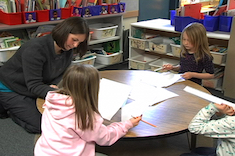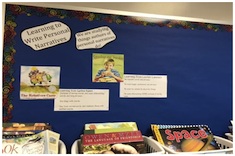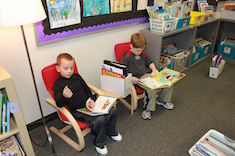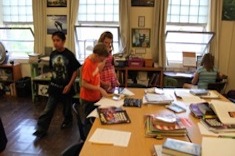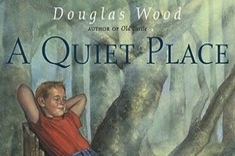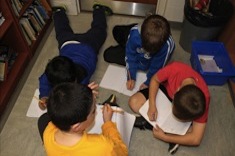Free Samples
Try some samples of Choice Literacy's premium content for members. If you'd like more free content delivered weekly to your inbox, sign up for our free newsletter, the Big Fresh.
Latest Content
A Variety of Share Sessions
Ruth Ayres catalogs her favorite types of share sessions (from old favorites to creative innovations) in writing workshops.
First-Grade Conference: Stretching Writing
Katrina Edwards helps her adorable first-grade student Dylan stretch out his writing. He adds details by first talking about playing with friends near his home.
Planning for Small-Group Word Study
Stephanie Affinito offers five guiding principles and a template for planning small-group word study.
Planning for a Narrative Writing Unit of Study
Franki Sibberson believes planning a unit of study should be just as much fun as planning a trip to Disney World. She explains her planning process for one of her first units of study, on narrative writing.
Explaining a Workshop Model to Parents
Jennifer Schwanke explains why parent-teacher conferences can be bewildering for families, and offers advice for better ways to explain a literacy workshop model to them.
Mentor Texts and Important Reminders
Melanie Meehan shares four important tips for using mentor texts effectively with students of any age.
Goal-Setting Ideas for Students
Melanie Meehan shares a wealth of ideas for better goal-setting with students.
Visual Essays
Gretchen Schroeder finds visual essays are a fun option for her high school students to present what they have learned just before Christmas break.
Teaching Students How to Give Revision Suggestions
Franki Sibberson shares a lesson progression to help students learn how to give helpful revision feedback. She uses online videos and resources to support her work.
Using Paired Texts with Beginning Readers
Shari Frost explains how teachers can use paired texts to help young readers build their skills, starting with books they already know and love.
Creating a Culture of Book Love
Tara Smith shares some of her favorite online resources for keeping up with new books, as well as organizing tips for classroom libraries.
Bridging the Gap Between Intervention and the Classroom
Kate Mills and Tara Barnett share strategies for building bridges between intervention and classroom instruction.
Mentors for Process and Habits
Ruth Ayres shares some of her favorite mentors and mentor texts for developing good writing processes and habits.
Putting the “Gradual” Back into Gradual Release of Responsibility
If it’s not sudden release of responsibility or no release of responsibility, what does gradual look like? Clare Landrigan and Tammy Mulligan bring this model to life.
Alternatives to Home/School Reading Logs
There may be few literacy homework assignments more despised by families than the dreaded reading log. Gigi McAllister proposes some alternatives, and explains how she keeps families in the loop on reading progress.
Resources for Quick-Writes
Katherine Sokolowski shares some of her favorite resources to jumpstart student interest in writing.
Potato the Crow: Blurring the Lines Between Reality, Fantasy, and Play with Young Learners
Leslie Woodhouse discovers a dollar store find takes on a life of its own in her preschool classroom in this delightful essay.
Redefining Just-Right Books
Jan Burkins and Kim Yaris share advice for rethinking how teachers and students define “just-right” texts.
Student Learning Targets
Christy Rush-Levine finds she has to rethink learning targets for her middle school students if she wants students to pursue complex and lifelong reading goals.
Releasing Responsibility
When it comes to producing independent readers and writers in classrooms, it’s all about the language we use. Debbie Miller has practical suggestions for bringing out the best in children.
How Long?
Ruth Ayres provides a ready reference guide for the typical length of everything from a minilesson to a conferring session.
The Power of Written Blind Word Sorts
Max Brand uses written blind word sorts to build student word learning skills.
Three Questions to Ask When a Guided Reading Group Is Stuck
Jan Burkins and Kim Yaris share three questions teachers should ask themselves when guided reading groups aren’t going well.
Classroom Management and Student Responsibility
Katherine Sokolowski is discouraged when she observes that some students are off-task during literacy workshops. She decides a reflection sheet will be a useful weekly scaffold to support independent monitoring of behavior.
Student-Generated Blends Chart in First Grade
Katie DiCesare’s first graders add to a blends chart during reading transition time.
Close Reading and Multiple Layers in Middle School
Christy Rush-Levine uses striking texts that inspire multiple readings by her middle school students.
A Strong Foundation: Books and Media for Launching Literacy Workshops
Help students transition back to school with minilessons that give children a strong sense of the purpose of literacy workshops.
Curriculum Night? No Sweat
Curriculum night? No sweat says Tony Keefer. Only kidding — there is a lot of sweat involved, but Tony’s humorous account of how he has changed his curriculum night presentation will get you thinking about new ways of connecting with families.
How to Eat an Elephant One Bit(e) at a Time: Reading Complex Texts
Maggie Beattie Roberts and Kate Roberts present a step-by-step process for close reading in the middle and high school grades involving multiple passes through the same text.
Using Shared Writing to Build Argument Skills
Shari Frost explains the power of shared writing in intermediate classrooms, especially for struggling learners.
Browse Content By
Type
Category
- Assessment Tools
- Big Fresh Archives
- Booklists
- Choice Numeracy
- Classroom Design
- Common Core
- Community Building
- Conferring
- Content Literacy
- Digital Literacy
- English Language Learners
- Equity
- Family Relations
- Free Samples
- Guiding Groups
- Leadership
- Literacy Coaches
- Mentor Texts
- Minilessons
- New Teacher Mentors
- Podcasts
- Poetry
- Quote Collections
- Reading Strategies
- Self Care
- Struggling and Striving Learners
- Talking and Listening
- Teacher Study Groups
- Teaching Reading
- Teaching Writing
- Word Study and Vocabulary
Author
- Melissa Quimby
- Nawal Qarooni
- Gwen Blumberg
- Julie Cox
- The Lead Learners
- Hannah Tills
- Josie Stewart
- Ruth Metcalfe
- Mallory Messenger
- Becca Burk
- Jodie Bailey
- Vivian Chen
- Mary Brower
- Tiffany Abbott Fuller
- Stephanie Affinito
- Ruth Ayres
- Leigh Anne Eck
- Heather Fisher
- Shari Frost
- Julie Johnson
- Suzy Kaback
- Gigi McAllister
- Shirl McPhillips
- Melanie Meehan
- Cathy Mere
- Debbie Miller
- Tara Barnett and Kate Mills
- Tammy Mulligan
- Dana Murphy
- Bitsy Parks
- David Pittman
- Brenda Power
- Heather Rader
- Matt Renwick
- Mandy Robek
- Christy Rush-Levine
- Gretchen Schroeder
- Jen Schwanke
- Brian Sepe
- Katherine Sokolowski
- Stella Villalba
- Jennifer Vincent
Grade Level
Choice Literacy Membership
Articles
Get full access to all Choice Literacy article content
Videos
Get full access to all Choice Literacy video content
Courses
Access Choice Literacy course curriculum and training



